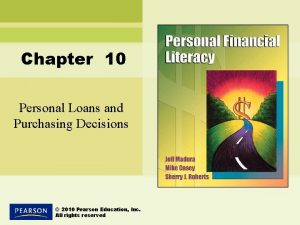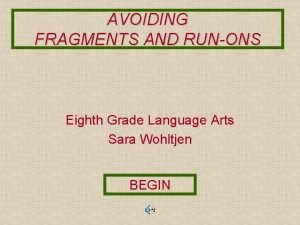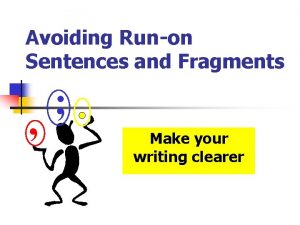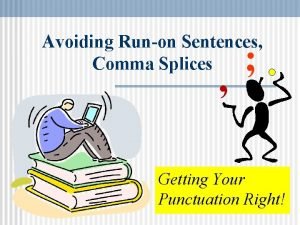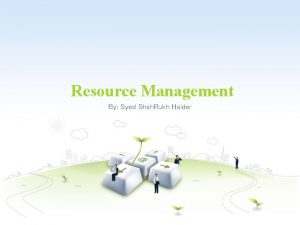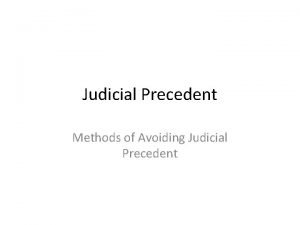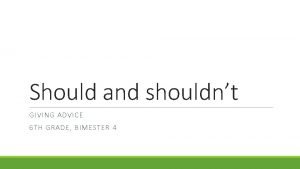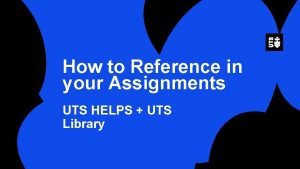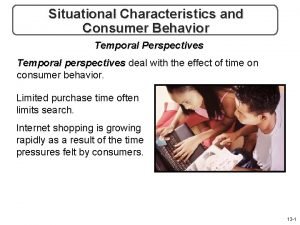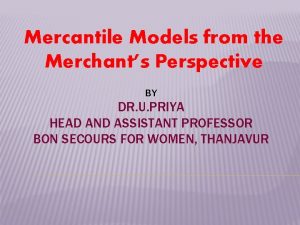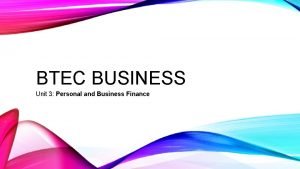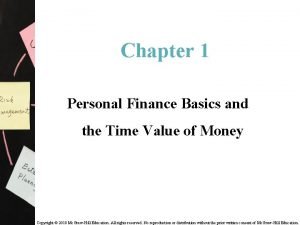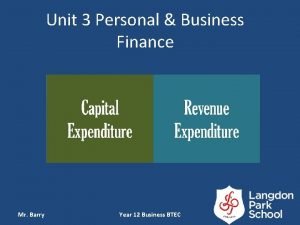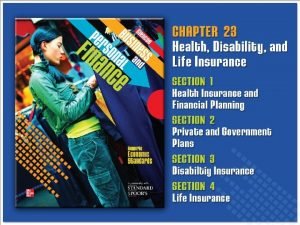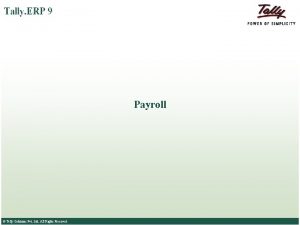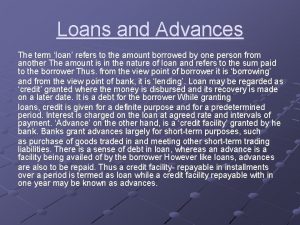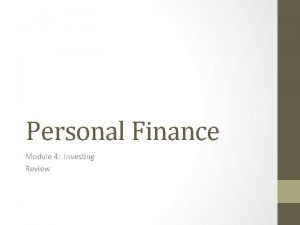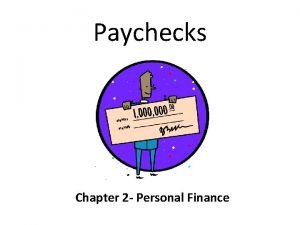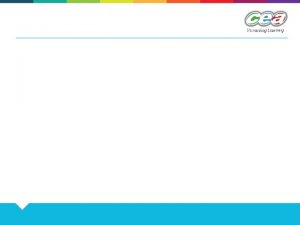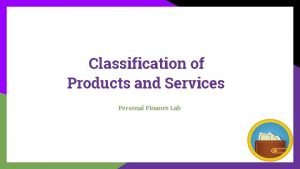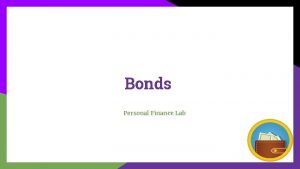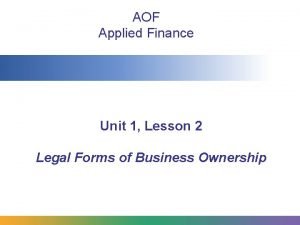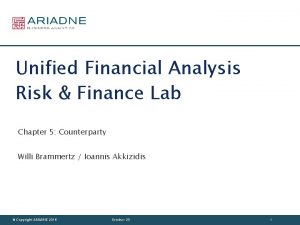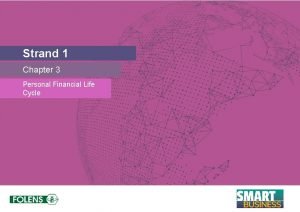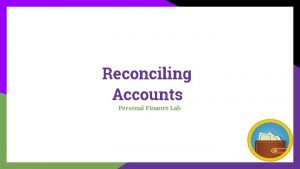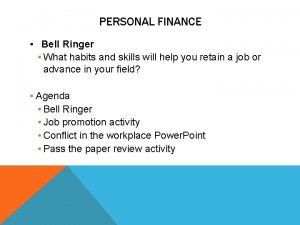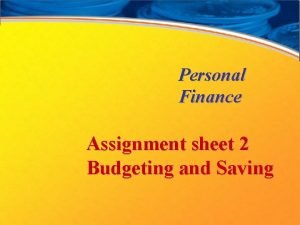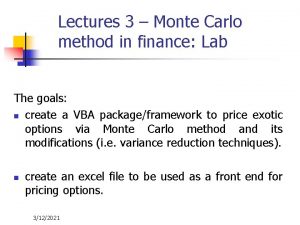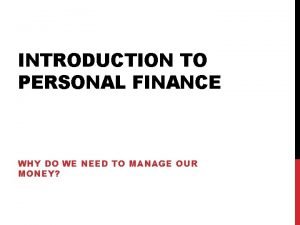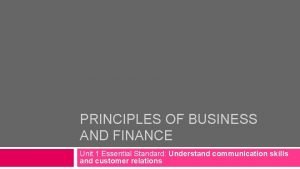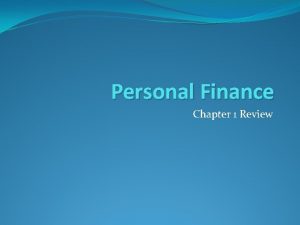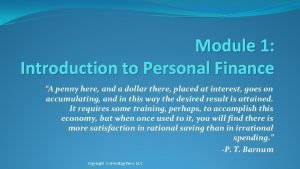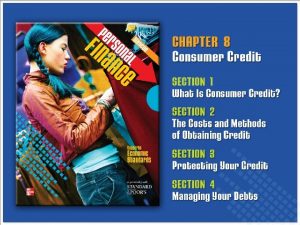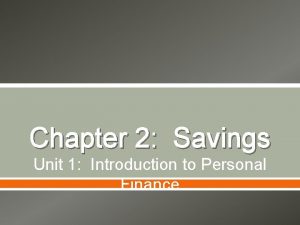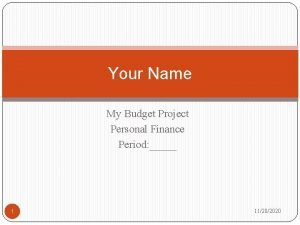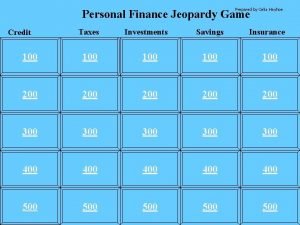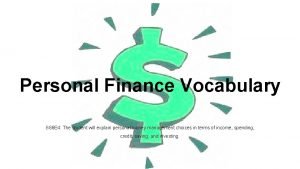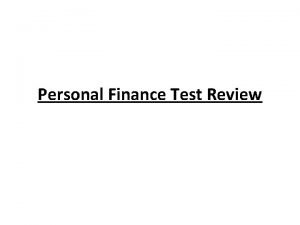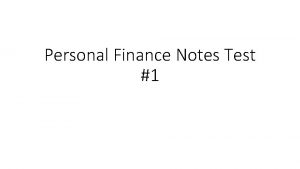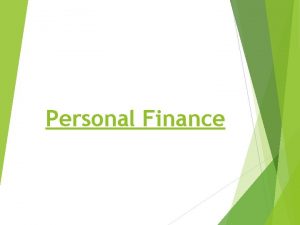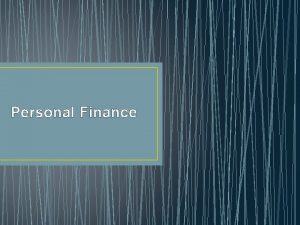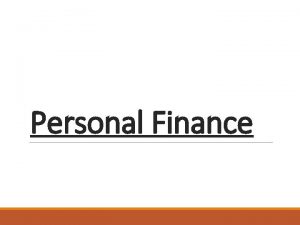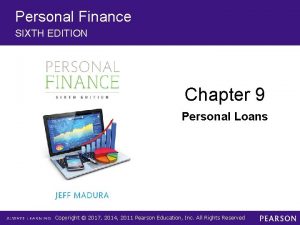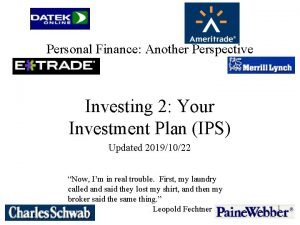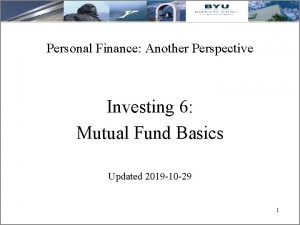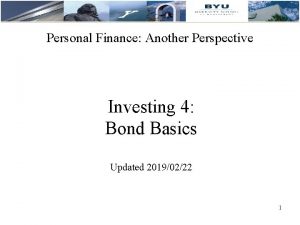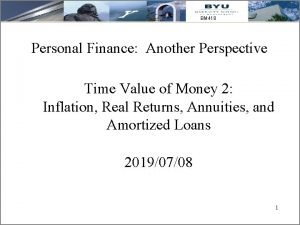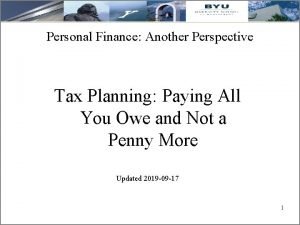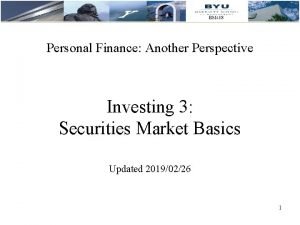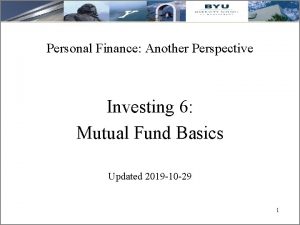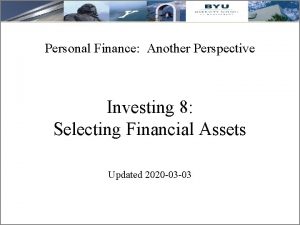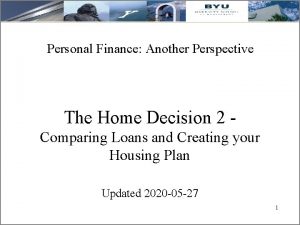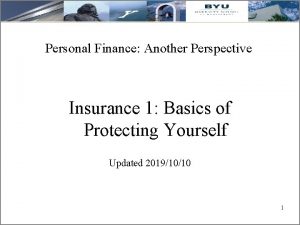Personal Finance Another Perspective Loans Avoiding Consumer and

































































- Slides: 65

Personal Finance: Another Perspective` Loans: Avoiding Consumer and Minimizing Mortgage Updated 2019 -02 -05 Note: Graphs on this presentation are from http: //www. bankrate. com/funnel/graph/default. aspx? 1

Objectives A. B. C. D. Understand consumer loans, principles, types, characteristics, and costs Understand mortgage loan types, characteristics, and costs Understand the key relationships for borrowing Understand Consumer and Student Plans and Strategies 2

Your Personal Financial Plan IX. Student/Consumer Loans and Debt Reduction? (Loans and Debt Template LT 01 -08) • What is your vision and goals for consumer/student loans and debt outstanding? • What is your current debt situation with interest rates, costs, and other fees? • What are your plans and strategies for consumer and student debt? • If in debt, what is your debt reduction strategy and views on future debt? • What are your constraints and accountability? 3

Case Study Data • Anne is looking at the mortgage cost of a $300, 000 6. 0% fixed rate 30 year amortizing loan versus a 7. 0% fixed rate 30 year loan with an 10 year interest only option. Calculations • A. What are her monthly payments for each loan for the first 10 years? • B. What is her new monthly payment beginning in year 11 after the interest only period ends? Application • C. How much did Anne’s monthly payment rise in year 11 in percentage terms for the interest only loan? 4

A. Understand Consumer Loans, Principles, Types, Characteristics and Costs • Why are consumer loans not recommended? • 1. They encourage consumption instead of saving • Rather than saving for the future, they encourage spending now • 2. They are very expensive, and crowd out saving • They reduce what you might otherwise have saved for your other more important goals • 3. They are generally unnecessary • Other than for education and a home (what the prophet has stated), they generally are not necessary! 5

Consumer Loans (continued) • What 5 questions should you ask when you are thinking of borrowing (using consumer loans)? • • 1. Do you really need to make this purchase? 2. Is it in your budget and your financial plan? 3. Can you pay for it without borrowing? 4. What is the all-in cost of this loan, including its impact on your other goals? • 5. Will this purchase bring you closer or take you farther away from your personal goals (including your goal to be obedient to God’s commandments)? 6

Principles (continued) • What are the principles of consumer loan use? • 1. Know yourself, your vision, goals and budget • 2. Seek, receive and act on the Spirit’s guidance • 3. Know where you are financially (your assets, liabilities, spending and income) • 4. Resolve to not go into debt (except for a modest home and modest education) • 5. Pay as you go (live within your means) • If in debt add: • 6. Prioritize your debts (if you cannot repay them all, give priority to secured debts for house or car) • 7. Develop a repayment plan (and automate it) • 8. Avoid all new debt (don’t go further into debt) 7

Principles (continued) Finding balance Principles • Know yourself, your vision and goals • Seek, receive and act on guidance • Know where you are financially • No debt except for home and education • Live within your means Doctrines Identity Obedience Accountability Agency Stewardship 8

Principles (continued) From obedience to consecration • I am a child of a King (identity), striving to live worthy of the Spirit (obedience), using my agency wisely (stewardship) as I follow the prophet and scriptures in deferring my wants (agency). I wait until I can pay cash for specific items (stewardship), so that I am a wiser steward over the things that I have been blessed with (stewardship) so I can accomplish my personal mission and individual and family vision and goals 9

Characteristics • What are the different types • Security of Consumer loans • Secured • Types • Single payment loans • Installment loans • Rates • Fixed • Variable • Convertible • Balloon • Unsecured • Home Related • Home Equity • HELOC • Specialty • Auto loans • Student loans • Payday loans 10

Characteristics (continued) • Types • Single Payment • Loan is repaid in one payment of principle and interest • Installment • Loan is repaid in regular intervals with payments that include both principal and interest 11

Characteristics (continued) • Security • Secured - Loans are guaranteed by a specific asset, i. e. a home or a car, and typically have lower rates • Unsecured - Loans that require no collateral, are generally offered to only borrowers with excellent credit histories, and have higher rates of interest – 12% to 28% (and higher) annually 12

Characteristics (continued) • Rate Type • Fixed-rate loans • Same interest for the duration of the loan with generally a higher interest rate • Variable-rate loans • Interest rate is tied to an index plus some margin, adjusted on different intervals • Convertible loans • Begin as a variable-rate loan and can be locked into a fixedrate loan at some predetermined future time 13

Characteristics (continued) • Home Related • Home equity loans • Second mortgages which use the equity in your home to secure your loan. Normally can borrow up to 80% of your equity and rates are • Home Equity Lines of Credit (HELOC) • A line of credit against your home equity which allows you to draw money from your home’s value and pay it off with interest, with rates normally adjustable 14

Characteristics (continued) • Specialty • Student loans • Loans to help offset the cost of an education • Auto loans • Loans secured by the vehicle the consumer is purchasing • Payday • Short-term loans of 1 -2 week secured by a postdated check—HUGE interest rates and fees 15

Costs of Consumer Loans • What are the costs of consumer loans? • Consumer loans are required by Regulation Z of the Truth in Lending Act to state the loan APR in bold on the loan documents • The APR is the simple interest rate paid over the life of the loan. It takes into account all costs, including interest rate, cost of credit reports, and costs of all possible fees • Loans are either single payment, installment or payday 16

Single Payment Loans • Single payment (or balloon) loans • A loan that is repaid in only one payment, including interest • Generally is short-term lending of one year or less, sometimes called bridge or interim loans • Cost is simple interest • Both principal and interest are due at maturity, with interest is calculated as principal x interest rate x time APR = [(interest+Fees)/Years]/Avg. borrowed Calculating Consumer Loan Costs (LT 42) may be helpful • • 17

Installment Loans • Installment loans are loans which are repaid at regular intervals and where payment includes both principal and interest • Cost is also Simple Interest • Most installment loans today are based on a simple-interest calculation (your calculator) • Repayment is on your outstanding balance, as each month the interest portion of the payment decreases and the principal portion increases • 18

Payday Loans • Short-term loans of 1 -2 weeks secured with a postdated check which is “held” by the lender and then cashed later with huge rates APR > 520% • Cost is the APR • Interest plus fees divided by years and by average amount borrowed • To get the effective rate, take the APR of the loan in decimal form, divide it by the number of compounding periods, add 1, and take it to the power of the number of periods, and subtract 1 19

20

C. Understand Mortgage Loan Types, Characteristics and Costs • There a number of different loan options when considering how to finance your house. Your choice of loans should be based on three areas: • 1. Your time horizon: How long do you expect to have the mortgage, and how certain are you of that time horizon? • 2. Your preference (if any) for low required payments: How important are lower payments in the initial years of the loan? • 3. Your tolerance for interest rate risk: Are you willing to assume interest rate risk? • 4. Your work status/history: Are you or have you been a member of the armed forces? 21

Mortgage Loans (continued) • Types of Loans • Conventional loans: neither insured or guaranteed • They are below the maximum amount set by Fannie Mae and Freddy Mac of $484, 350 in 2019 (single family) • They require Private Mortgage Insurance (PMI) if the down payment is less than 20% • PMI is insurance to make the lender whole should the borrower fail to make payments • Borrowers can eliminate PMI by having equity greater than 20% 22

Mortgage Loans (continued) • Jumbo loans • Loans in excess of the conventional loan limits and the maximum eligible for purchase by the two Federal Agencies, Fannie Mae and Freddy Mac, of $484, 350 in 2019 (some areas have higher amounts) • Some lenders also use the term to refer to programs for even larger loans, e. g. , loans in excess of $500, 000 23

Mortgage Loans (continued) • Piggyback loans • Two separate loans, one for 80% of the value of the home and one for 20% • The second loan has a higher interest rate due to its higher risk • The second loan is used to eliminate the need for PM Insurance • With a piggyback loan, PMI is not needed 24

Mortgage Loans (continued) • There a number of different types of mortgage loans available. These include: • Fixed rate mortgages (FRMs) • Variable or adjustable rate mortgages (ARMs) • Variable or Fixed Interest Only Option (IO) • Option Adjustable Rate Mortgages (Option ARMs) • Negative Amortization (Neg. Am) • Balloon Mortgages • Reverse Mortgage • Special Loans: VA or FHA 25

Mortgage Loans (continued) • Fixed rate mortgages (FRMs) • Fixed rate of interest for the life of the loan, and least risky from the borrowers point of view • Benefits • Higher monthly payments, so pay down principle faster • Interest rate risk is transferred to the lender • No risk of negative amortization • Risks • Interest rates are higher as lenders must be compensated for 26

Mortgage Loans (continued) • Variable or ARMs • Mortgage loans with a rate of interest that is pegged to a index that changes periodically, plus • Benefits • Lower monthly payments and rates, as interest rate risk is assumed by the borrower • Risks • Lower monthly payments initially as borrows assume interest rate risk • Possible “payments shock” as rates rise, perhaps beyond what borrowers are able to pay 27

Mortgage Loans (continued) • Fixed/Variable Loan with Interest only option • FRMs or ARMs with an option for interest only payments for a number of years, and then payments reset to amortize loan over the remaining years – generally not recommended • Benefits • Lower monthly payments and greater flexibility • Borrowers can afford more house • Risks • Once interest-only period passes, payment resets, and the payment increase can be large • A rise in payments when interest period ends 28

Mortgage Loans (continued) • Option Adjustable Rate Mortgages (Option ARMs) • ARM where rates adjust monthly, and payments annually, with “options” on the payment amount: minimum, interest only, and fully amortizing -- never recommended!!!!! • Benefits • Lower monthly payments and greater flexibility • Risks • The minimum payment option often results in a growing loan balance, termed negative amortization, which has limits and will cause loan to be reset • A huge payments rise when interest period ends 29

Mortgage Loans (continued) • Negative Amortization Mortgages (Neg. Am) • Mortgage loans in which scheduled monthly payments are insufficient to amortize, or pay off the loan. • Benefits • Lower payments • Risks • Interest expense that has been incurred, but not paid, is added to the principal amount, which increases the amount of the debt. • Neg. Am loans have a maximum negative amortization that is allowed. Once that limit is hit, rates adjust automatically 30

Mortgage Loans (continued) • Balloon Mortgages • Mortgage loans whose interest and principal payment won’t result in the loan being paid in full at the end of the term. • Benefits • Allow smaller interest payments • These loans are often used when the debtor expects to refinance the loan closer to maturity • Risks • The final balloon payment can be huge • You may not be able to refinance at a rate you would like 31

Mortgage Loans (continued) • Reverse Mortgages • Mortgage loans whose proceeds are made available against the homeowners equity. • Financial institutions in essence purchase the home and allow the seller the option to stay in the home until they die • Benefits • Used by cash-poor but home-rich homeowners who need to access the equity in their homes to supplement their monthly income at retirement • Risks • Once they die, the home is sold and the loan repaid, generally with the proceeds 32

Mortgage Loans (continued) • Federal Housing Administration (FHA) Insured Loans • Does not originate loans, but insures loans issued by others • Benefits • Lower PMI insurance (. 85%), but required for the entire life of the loan (1. 75% of the loan) • Risks • While the required down payment is very low, the maximum amount that can be borrowed is also low 33

Mortgage Loans (continued) • Veterans Administration (VA) Guaranteed Loans • These loans are issued by others and guaranteed by the Veterans Administration • Benefits • For ex-servicemen and women as well as those on active duty • Loans may be for 100% of the home value • Risks • With not down payment, the risk remains of owing more than the house is worth 34

35

Questions • Any questions on types of mortgage loans? 36

C. Understand Key Relationships and How to Reduce Borrowing Costs • Key to your plans and strategies is reducing your costs • 1. Understand the Key Relationships on Borrowing: • Total interest cost is related to the interest rate • Keep your interest rate as low as possible • Total interest cost is inversely related to maturity • Keep your loan maturity short • Periodic payment is directly related to both the maturity and interest rate • Keep both short • Parents are cheaper than banks 37

Relationships and Borrowing Costs (continued) • 2. Understand the key clauses for Consumer and Mortgage Loans—none are in your favor! • Note that all clauses are in the lender’s favor, and very few, if any, are in the borrower’s favor. • You are putting your future in someone else’s hands when you borrow! • You are committing future earnings to today’s consumption! • Know what your are doing before you do it!!!!! • Read the documents very carefully and understand them before you sign!!! 38

Relationships and Borrowing Costs (continued) • Insurance agreement clause • Requires you to purchase life insurance that will payoff your loan in case you die before the loan is paid off • Benefits only the lender, and increases your total loan cost • Acceleration clause • Requires the entire loan to be paid-in-full if you miss just one payment • Normally (but not always) this is not invoked if you make a good faith effort to pay 39

Relationships and Borrowing Costs (continued) • Deficiency payments clause • Requires any amount in excess to be paid if the collateral's value does not satisfy the loan. • Borrower must also pay any outstanding charges incurred by the lender associated with the disposal of the collateral • Recourse clause • Defines the lender’s ability to collect any outstanding balance via wage attachments and garnishments • Can also include liens on other borrower’s property 40

Relationships and Borrowing Costs (continued) • 3. Know the steps to reduce borrowing costs • a. Don’t get into debt in the first place! • Follow the prophet—rather than your wants! • Distinguish between true needs and wants • Remember your goals • Remember ignorance, carelessness, compulsiveness, pride, and necessity are offset by knowledge, exactness, discipline, humility, and self reliance • Stick to your budget • If you really need it, plan and save for it 41

Relationships and Borrowing Costs (continued) • b. Compare the after-tax cost of borrowing with the after-tax lost return from using savings • It makes little sense to borrow at a high interest rate when you have savings earning a lower rate. The formula is: • After-tax lost return = nominal interest rate * (1 – tax rate) • Tax rate = Federal + State + Local marginal tax rates • Be careful though, to not put your house at risk! 42

Relationships and Borrowing Costs (continued) • c. Maintain a strong credit rating • Increase your credit score • Make sure your credit reports have no mistakes • Pay all your bills on-time • Keep balances low, particularly on revolving debt • Keep your oldest accounts, but not too many • Don’t apply for too many new cards • Don’t have too many of the same type of cards • Call and increase your credit limits (if possible) 43

Relationships and Borrowing Costs (continued) • d. Reduce the lender’s risk • • a. Use a variable rate loan b. Keep the loan term as short as possible c. Provide collateral for the loan d. Pay a large down payment on the item to be purchased with financing 44

Relationships and Borrowing Costs (continued) • Least expensive • Most expensive • Borrowing from parents • Credit cards and family • Retail stores • Home equity loans • Finance companies and • Other secured loans payday lenders • More expensive • Isn’t it interesting that those who are in • Credit unions the worst financial • Savings and loans situation have to pay • Commercial banks the most for credit 45

D. Consumer, Student and Mortgage Loan Plans and Strategies • We have already discussed your Consumer Loans and Debt Plan earlier • However, we can add a few more thoughts to your plans and strategies 46

Plans and Strategies (continued) • Plans and Strategies – Consumer Loans • • • We will separate needs from wants We defer all wants until we can pay cash for them We pay cash for all consumer purchases We will pay off all credit cards monthly We keep our emergency fund at 3 months and rebuild it quickly once it is drawn down • We will never buy toys with debt 47

Plans and Strategies (continued) • Plans and Strategies – Student Loans • We will seek scholarships as much as possible • We will spend loan money only on education • We defer all wants until we can pay cash for them and after we have paid off our student loans • We will understand our employment options to help pay off our student loan debt • We build our emergency fund to 3 months and then use the 20%+ to pay down non-subsidized and then subsidized loans • We will not buy toys until our student loans are all paid off 48

Plans and Strategies (continued) • Plans and Strategies – Mortgage Loans • We strive to have a 20% down payment to reduce the need for PMI • We ensure all housing payments are within the front - and back-end ratios recommended • We avoid debt like the plague • We keep our emergency fund at 3 months and rebuild it quickly when it is drawn down • We defer all wants until we can pay cash for them, except for student and mortgage loans • We will not borrow against the equity in our home • We will go into retirement out of mortgage debt 49

Review of Objectives A. Do you understand consumer loans, principles, types, characteristics, and costs? B. Do you understand mortgage loan types, characteristics, and costs? C. Do you understand the key relationships for borrowing? D. Do you understand some additional Consumer and Student Plans and Strategies? 50

Case Study #1 Data • Anne is looking at the mortgage cost of a $300, 000 1. traditional fixed rate 6. 0%, 30 year amortizing loan versus 2. a fixed rate 7. 0%, 30 year loan with an 10 year interest only option. Calculations • A. What are her monthly payments for each loan for the first 10 years? • B. What is her new monthly payment beginning in year 11 after the interest only period ends? Application • C. How much did Anne’s monthly payment rise in year 11 in percentage terms for the interest only loan? 51

Case Study #1 Answers • A. Anne’s monthly payments are • Traditional: The amortizing loan payment is: PV=-300, 000, I=6. 0%, P/Y=12, n=360, PMT = ? • PMT = $1, 798. 65 • Interest only: Payment is $300, 000*7. 0%/12 = ? • $1, 750. 00 • B. After the 10 year interest only period, her new payment would be (she would have to amortize the 30 year loan over 20 years): • PV = -300, 000, I=7. 0%, P/Y=12, N= 240, PMT = ? • PMT = $2, 325. 89 • C. The new payment is a 33% increase (LT 12) 52

Case Study #2 Data • Matt is offered a $1, 000 single payment loan for 1 year at an interest rate of 12%. He determines there is a mandatory $20 loan processing fee, $20 credit check fee, and $60 insurance fee. The calculation for determining the APR is (annual interest + fees) / average amount borrowed. (LT 42) Calculations • A. What is Matt’s APR for the 1 year loan assuming principle and interest paid at maturity? • B. What is Matt’s APR if this was a 2 year loan assuming principle and interest paid at maturity? 53

Case Study #2 Answers • Matt’s interest cost is Prin. * Rate * Time • A. The APR for the 1 year loan is: • Interest = $1, 000*. 12*1 year = $120, Fees: $20+$60=$100 • APR = (120 + 100) / 1, 000 = 22. 0% • B. The APR for the 2 year loan is: • Interest = $1, 000*. 12*2 = $240 • Fees: $20 + $60 = $100 • APR = [(240+100)/2]/1, 000= 17. 0% • Since this is a single payment loan, the average amount borrowed is the same over both years. • Note that Matt’s APR is significantly higher than his stated interest rate. He should be very careful if taking out this loan. 54

Case Study #3 Data • Matt has other options with the same $1, 000 loan at 12% for 2 years. But now he wants to pay it back over 24 months and he has no other fees. Calculations • Using the simple interest and monthly payments calculate: • A. The monthly payments • B. The total interest paid • C. The APR of this loan • Note: The simple interest method for installment loans is simply using your calculator’s loan amortization function 55

Case Study #3 Answers • A. To solve for simple interest monthly payments, set your calculator to monthly payments, end mode: • PV=-1, 000, I=12%, P/Y= 2, N=24, PMT=? • PMT = $47. 074 • B. Total Interest = 47. 074 x 24 – 1, 000 = ? • $129. 76 • C. APR = [(interest + fees) / 2] / average amount borrowed (which changes each year as you pay it down). (See the following slide to see how to get the average amount borrowed of $540. 68. ) • ($129. 76 / 2 years) / $540. 68 = 12% 56

Case Study #4 Data • You are looking to finance a used car for $9, 000 for three years at 12% interest. Calculations • A. What are your monthly payments? • B. How much will you pay in interest over the life of the loan? • C. What percent of the value of the car did you pay in interest? 57

Case Study #4 Answers • A. To solve for your payments, set: • PV= -9, 000, I = 12, N=36, and PMT=? • Your payment is $298. 93 per month B. To get your total interest paid, multiply your payment * 36 months = $10, 761. 44 – 9, 000 = ? • $1, 761. 46 C. To determine what percent of the car you paid in interest, divide interest by the cars cost of $9, 000 = $1, 761. 46 / 9, 000 = 19. 6% • You paid nearly 1/5 the value of the car in interest. 58

Case Study #5 Data • Bill is short on cash for a date. He und he can give a post-dated check to a Payday lender who will give him $100 now for a $125 check which the lender can cash in 2 weeks. The APR is the total fees divided by the annual amount borrowed. The effective annual rate = (1 + APR/periods) periods -1. Calculations • A. What is the APR? • B. What is the effective annual interest rate? Application • C. Should he take out the loan? 59

Case Study #5 Answers • A. the APR is the amount paid on an annual basis divided by the average amount you borrow • APR = ($25 * 26 two-week periods)/$100 =? • APR = 650% • B. To solve for your Effective Annual Interest rate, put it into the equation for determining the impact of compounding. • The effective annual interest rate is • (1 +[ 6. 5/26 periods])26 periods – 1 = • Effective rate is 32, 987% • This is a very expensive loan • C. No. It is just too expensive 60

Case Study #6 Data • Wayne is concerned about his variable rate mortgage (ARM). Assuming a period of rapidly rising interest rates, how much could his rate increase over the next 4 years if he had a 6 percent variable rate mortgage with a 2 percent annual cap (that he hits each year) and a 6 percent lifetime cap? Application • How would this affect his monthly payments? 61

Case Study #6 Answers • Assuming rates increased by the maximum 2% each year, at the end of the 4 years it could have reached its cap of 6%, giving a 12 percent rate. Nearly doubling the interest rate would significantly increase Wayne’s monthly payment. 62

Case Study #7 Data • Jon took out a $300, 000, 30 year Option ARM mortgage for purchasing his home, which had a 7% mortgage. Each month he could make a minimum payment of $1, 317 (which didn’t even cover interest), an interest only payment of $1, 750, a payment of $1, 996 that included both principle and interest, or an additional amount. The loan had a negative amortization maximum of 125% of the value of the loan. Jon was not very financially savvy, and for the first 10 years made the minimum payment only. As a result, at the end of year 10, he was notified that he had hit the negative amortization maximum and that his loan had reset. Calculations • A. What is Jon’s new monthly payment beginning in year 11 after he hit the negative amortization limit? • B. How much did Jon’s monthly payment rise over the minimum payment he was paying previously? 63

Case Study #7 Answers • A. After the negative amortization limit is hit, he must now amortize the loan over 20 years, instead of 30. • His new loan amount is not $300, 000, but $375, 000 (300, 000 * 125%) : • PV = -375, 000, I=7. 0%, P/Y=12, N= 240, PMT = ? • PMT = $2, 907. 37 • B. His minimum payment was $1, 317, and his new payment is $2, 907. • It is a 121% increase over the minimum payment period. 64

Notes • Other good sources of information on mortgages are available at: • www. mtgprofessor. com • www. bankrate. com 65
 Producers primary consumers secondary consumers
Producers primary consumers secondary consumers Chapter 10 personal loans and purchasing decisions
Chapter 10 personal loans and purchasing decisions Avoiding fragments and run-ons
Avoiding fragments and run-ons Bed making articles name
Bed making articles name Chapter 12 lesson 2 improving your fitness
Chapter 12 lesson 2 improving your fitness Chapter 5 consumer markets and buyer behavior
Chapter 5 consumer markets and buyer behavior Consumer markets and consumer buyer behavior
Consumer markets and consumer buyer behavior How to avoid foolish opinions questions and answers
How to avoid foolish opinions questions and answers Demographic parity
Demographic parity Turtle leadership style
Turtle leadership style Run on sentences game
Run on sentences game Avoiding insider trading training
Avoiding insider trading training Collaborating owl style
Collaborating owl style Avoiding run on sentences
Avoiding run on sentences Hr department structure
Hr department structure Evans v triplex safety glass
Evans v triplex safety glass N born
N born What's the best strategy for avoiding atm fees?
What's the best strategy for avoiding atm fees? Complete the introduction giving advice on avoiding
Complete the introduction giving advice on avoiding Uts apa guide
Uts apa guide Avoiding the sun
Avoiding the sun A national policy of avoiding involvement in world affairs
A national policy of avoiding involvement in world affairs The mysteries of harris burdick captain tory
The mysteries of harris burdick captain tory Decomposer in the sahara desert
Decomposer in the sahara desert Consumer diversity in consumer behaviour
Consumer diversity in consumer behaviour Consumer behaviour research process
Consumer behaviour research process Situational characteristics examples
Situational characteristics examples Mercantile model
Mercantile model 1 point vs 2 point perspective
1 point vs 2 point perspective Silo perspective vs business process perspective
Silo perspective vs business process perspective Btec unit 3 personal and business finance
Btec unit 3 personal and business finance Personal finance basics and the time value of money
Personal finance basics and the time value of money Unit 3 personal and business finance
Unit 3 personal and business finance Glencoe business and personal finance
Glencoe business and personal finance Loans and advances in tally
Loans and advances in tally Short term loans and advances
Short term loans and advances Module 4: investing test answer key
Module 4: investing test answer key Chapter 2 personal finance
Chapter 2 personal finance Personal finance gcse
Personal finance gcse Unsought products
Unsought products Personal finance lab
Personal finance lab Personal finance unit 1 lesson 5
Personal finance unit 1 lesson 5 Personal finance lab
Personal finance lab Personal life cycle
Personal life cycle Personal finance lab
Personal finance lab Personal finance 6th edition
Personal finance 6th edition Personal finance bell ringers
Personal finance bell ringers Personal finance assignment
Personal finance assignment Personal finance lab
Personal finance lab Introduction to personal finance
Introduction to personal finance Overview of personal finance chapter 1
Overview of personal finance chapter 1 Chapter 8 personal finance
Chapter 8 personal finance Principles of business and finance unit 1 test
Principles of business and finance unit 1 test Personal finance unit 1 review
Personal finance unit 1 review Chapter 4 review personal finance
Chapter 4 review personal finance Personal finance chapter 1
Personal finance chapter 1 Personal finance module
Personal finance module Glencoe personal finance
Glencoe personal finance Section 2 three basic reasons to save money
Section 2 three basic reasons to save money Overview of personal finance chapter 1
Overview of personal finance chapter 1 Personal finance budget project
Personal finance budget project Personal finance jeopardy
Personal finance jeopardy Personal finance vocabulary
Personal finance vocabulary Personal finance test
Personal finance test Personal finance project
Personal finance project Personal finance notes
Personal finance notes

